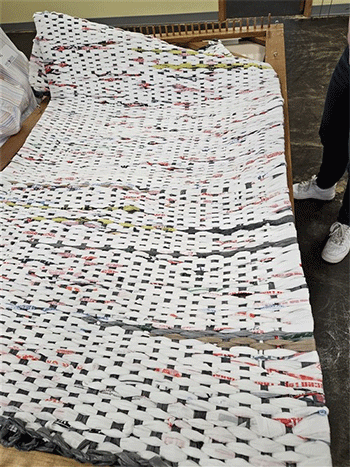Americans use 5 trillion plastic bags per year. Nearly 90 percent end up in landfills or the ocean. What’s more: It takes 1,000 years for a plastic bag to degrade in a landfill, and the bags don’t ever completely break down but instead become microplastics that absorb toxins and continue to pollute the environment.
Hope UMC in Blue Earth has found a way to put the bags to good use while doing their part to heed Jesus’ call to heal a broken world—one of the key gospel imperatives that the Minnesota Conference focuses on. Since this summer, they have been weaving plastic bags into sleeping mats for the homeless.
It started in June, when Hope UMC members Joni Jenkins and Florence Hacklander took a trip to the newly opened Midwest Mission distribution center in Jefferson, Iowa. They spent several days volunteering on a work team, and their project was using special looms to create the mats. They were intrigued and realized weaving the mats would be a great mission project for their church.
“They’re actually useful,” said Jenkins. “There’s absolutely no cost to this thing once you have the loom. And all the plastic that we get is used.”
The mats are about 40 inches wide and 70 inches long. They are lightweight, flexible, and provide a thermal barrier against dampness, grass, gravel, sand, and cold floors. They also repel bugs, which don’t like the plastic.

Hope UMC gets its plastic bags from members and from a local grocery store that set up a collection bin. Here’s the process for using them to create a mat: The bags are flattened, folded, and cut into five-inch loops. People take the loops and tie them into sections with slip knots. Then the sections are weaved together on a large loom.
The looms are crafted by volunteer carpenters, and Midwest Mission gives them out for a $100 donation. A benefactor from Hope UMC supplied the funds for two looms for the church, and they have since been put to good use.
Hope UMC’s weaving group meets from 1 to 4 p.m. on the first and third Thursdays of the month. Its members have produced six mats since they began weaving in mid-July, and Jenkins said her hope is they make at least two each month going forward. Periodically, they will deliver the finished mats to Midwest Mission—which encourages groups to distribute the mats within their own community first if and when there is a need.
Could you form a group in your local church to make the mats? Do you want a loom? Joni Jenkins says the best way to start is by spending a few days on a work crew at the Midwest Mission distribution center in Jefferson, Iowa, to learn how to do the weaving. You can then purchase a loom for a $100 donation and bring it back to your church to get started! Learn more
Hope UMC has 85 to 110 in worship on an average Sunday, and about a dozen people have participated in the weaving ministry to date. The opportunity has particularly been embraced by older women in the church, some of whom used to knit, sew, or crochet but no longer have the dexterity to do so. Joining the weaving ministry has given many participants a newfound sense of purpose.
For example, the mother of a man in the congregation had a stroke several years ago that greatly affected her mobility. The man asked the weaving group to show him how to assemble the loops of the plastic bags into two-loop strips that are later woven in. They did, and he in turn taught his mother—who has joyfully taken on that task ever since. Her happiness and sense of self-worth have both improved because she has a valuable new way to spend her time.
Jenkins said the best part of making the mats is that anyone can do it—and it’s great for smaller churches because you only need one to four people to make each mat.
Her prayer for those receiving a mat: “I hope they know that they were made by a supportive, prayerful people, and it gives them some comfort.”
Hope UMC plans to give one of its two looms to a former church member who is now teaching in New Mexico, where needs are great and people are ready and willing to fill those needs.
Jenkins and others from the weaving group are also teaching members of a nearby Lutheran church to make the mats, and Hope UMC’s benefactor will also purchase a loom for them.
“It’s our hope that the mission spreads,” Jenkins said.
excerpt from a story by Christa Meland, director of communications, Minnesota Annual Conference
This story represents how United Methodist local churches through their Annual Conferences are living as Vital Congregations. A vital congregation is the body of Christ making and engaging disciples for the transformation of the world. Vital congregations are shaped by and witnessed through four focus areas: calling and shaping principled Christian leaders; creating and sustaining new places for new people; ministries with poor people and communities; and abundant health for all.





